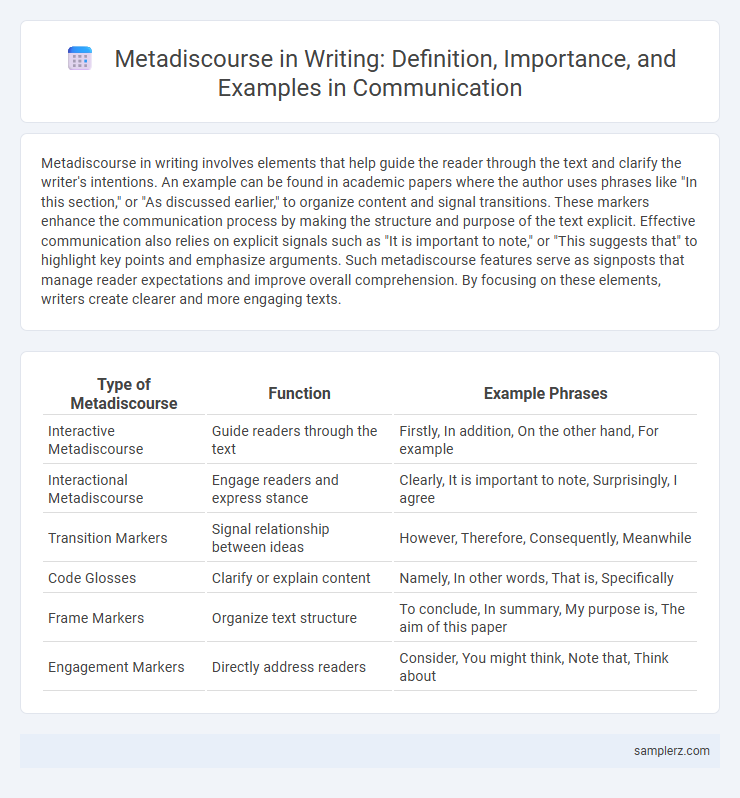Metadiscourse in writing involves elements that help guide the reader through the text and clarify the writer's intentions. An example can be found in academic papers where the author uses phrases like "In this section," or "As discussed earlier," to organize content and signal transitions. These markers enhance the communication process by making the structure and purpose of the text explicit. Effective communication also relies on explicit signals such as "It is important to note," or "This suggests that" to highlight key points and emphasize arguments. Such metadiscourse features serve as signposts that manage reader expectations and improve overall comprehension. By focusing on these elements, writers create clearer and more engaging texts.
Table of Comparison
| Type of Metadiscourse | Function | Example Phrases |
|---|---|---|
| Interactive Metadiscourse | Guide readers through the text | Firstly, In addition, On the other hand, For example |
| Interactional Metadiscourse | Engage readers and express stance | Clearly, It is important to note, Surprisingly, I agree |
| Transition Markers | Signal relationship between ideas | However, Therefore, Consequently, Meanwhile |
| Code Glosses | Clarify or explain content | Namely, In other words, That is, Specifically |
| Frame Markers | Organize text structure | To conclude, In summary, My purpose is, The aim of this paper |
| Engagement Markers | Directly address readers | Consider, You might think, Note that, Think about |
Understanding Metadiscourse in Academic Writing
Metadiscourse in academic writing functions as a tool to guide readers through complex arguments by signaling organization, emphasis, and the writer's stance. Examples include transitions like "for instance," markers such as "importantly," and hedges like "may suggest," which clarify the structure and tone of the discourse. Effective use of metadiscourse enhances reader comprehension and engagement by making the writer's intentions explicit.
The Role of Metadiscourse in Enhancing Clarity
Metadiscourse elements, such as transition markers, hedges, and engagement markers, play a crucial role in structuring writing and guiding readers through complex ideas, thereby enhancing clarity. By signaling relationships between ideas and managing readers' expectations, metadiscourse facilitates smoother comprehension and prevents misunderstandings. Effective use of metadiscourse contributes to a well-organized text, improving overall communication effectiveness in academic and professional writing.
Common Types of Metadiscourse Markers
Common types of metadiscourse markers in writing include interactive markers such as transitions, frame markers, endophoric markers, evidentials, and code glosses, which guide readers through the text and signal its structure. Interactional markers involve engagement elements like hedges, booster, attitude markers, self-mentions, and engagement markers that express the writer's stance and connect with the audience. These markers enhance clarity, coherence, and reader interaction by making the writing more organized and interactive.
Examples of Interactive Metadiscourse in Sentences
Interactive metadiscourse guides readers through the structure of a text by using signals like logical connectors and transitions such as "first," "however," or "on the other hand." Phrases like "in conclusion," "for example," and "to summarize" help organize content and clarify relationships between ideas, enhancing comprehension. Questions embedded in writing, such as "What does this mean?" or directives like "Consider the following example," actively engage readers and direct their interpretation.
Examples of Interactional Metadiscourse in Context
Interactional metadiscourse in writing includes phrases that engage readers and guide their interpretation, such as "consider," "it is important to note," or questions like "how does this affect the outcome?" These expressions help establish a connection between the writer and the audience by signaling attitude, emphasizing points, and inviting response. Effective use of interactional metadiscourse enhances clarity, reader involvement, and persuasive impact in academic and professional communication.
How Metadiscourse Guides Reader Interpretation
Metadiscourse in writing, such as phrases like "to clarify," "in other words," and "on the one hand," functions to direct the reader's interpretation by signaling the writer's intent and structuring information flow. These markers help readers navigate arguments, identify emphasis, and understand the writer's stance or attitude toward the content. Effective use of metadiscourse enhances clarity, cohesion, and engagement, ensuring the message is interpreted as intended.
Metadiscourse and Writer-Reader Relationship
Metadiscourse in writing includes phrases that guide readers through the text and clarify the writer's intentions, such as "in other words" or "as you can see." These markers establish a connection between the writer and reader, enhancing engagement and comprehension by signaling attitude, emphasis, or organization. Effective use of metadiscourse strategies helps build a collaborative writer-reader relationship, making the communication more interactive and reader-friendly.
Cultural Variations in Metadiscourse Usage
Metadiscourse usage varies significantly across cultures, with writers from East Asian contexts often employing more implicit and indirect forms compared to the explicit and direct style favored in Western academic writing. For instance, Japanese and Chinese authors may use fewer self-referential markers and hedges, aligning with cultural values of humility and harmony, whereas English writers frequently signal their stance to engage readers explicitly. These cultural differences impact how arguments are structured and how authors connect with their audience, illustrating the importance of cultural awareness in effective cross-cultural communication.
Improving Coherence with Metadiscourse Examples
Metadiscourse elements like transitions, frame markers, and endophoric markers significantly enhance coherence in writing by guiding readers through the text's structure and argument progression. For example, using transitions such as "firstly," "in contrast," and "finally" helps signal the organization of ideas, while frame markers like "to conclude" or "my purpose is" clarify the writer's intentions. Endophoric markers such as "as shown above" direct readers to earlier sections, creating a cohesive and connected reading experience.
Practical Tips for Using Metadiscourse Effectively
Effective metadiscourse enhances clarity by guiding readers through the text with phrases like "to illustrate," "consider the following," and "in summary." Writers should employ transitions and markers to signal argument structure and emphasize key points, ensuring cohesion and engagement. Regularly assessing audience needs and adjusting metadiscourse accordingly maximizes communication precision and readability.

example of metadiscourse in writing Infographic
 samplerz.com
samplerz.com